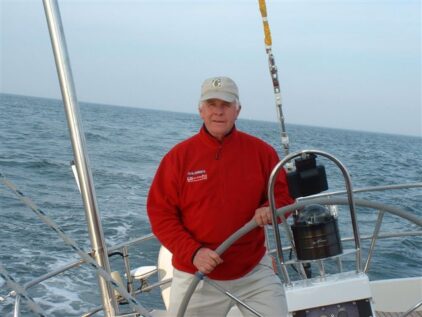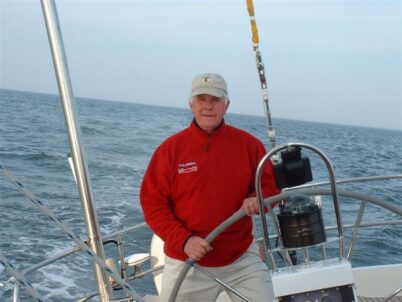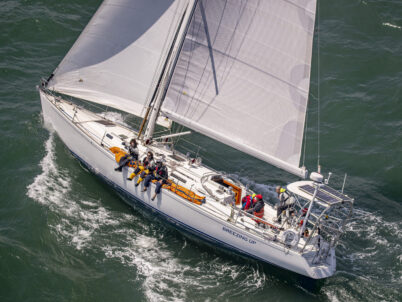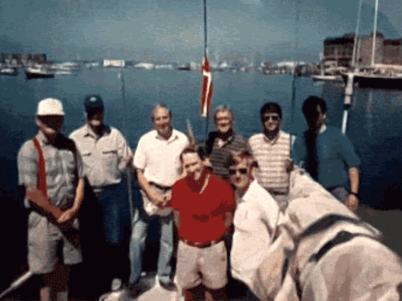The starboard navigation light lends an eerie, otherworldly glow to the rhythmic bow spray. Pound-pound- BAM! Pound – pound – BAM! Relentless couplets of five-foot waves and their seven-foot cousins vainly attempt to prevent or divert our proscribed course and destination. A consistent six-knot uptick in wind speed takes us beyond the wind range of the #1 medium genoa, and the call for “All hands – sail change!” brings crew members to assembly. From slumber, from reverie, from the boredom of rail riding or other appointed tasks, they come to this usually routine job.
And the job may be routine again - but it won’t be tonight. Decks are awash with green water and heeled up to 28 degrees while pitching and lurching through the brine. Wind howl and wave crash conspire and thereby necessitate that simple vocal acknowledgement between deckmates be exchanged with shouting. Foredeck-to-cockpit messages are only by relay. And then . . . there is the darkness. Moon phase and squall action form their own cabal to bring substantial limitations on the normal human vision component.
In the midst of this melee, two then three, then five or so crew members hunch up onto the foredeck. Harnessed and tethered, they are bent and ape-like in their movements. They go to work: tee-up the heavy #1; barber haul the leeward sheet; secure, man and tail both of the halyards and winches; raise and lower new and old sails simultaneously; finally, complete the transaction with the boxing of the medium genny on the windward rail. Skill, experience, brute force, rote memory, and substantial courage – all are called upon in more than ample measure in order to complete these tasks tonight. But the elements all appear together and the job is well done. Those and other daunting tasks will go on for one or two or five or more days until the finish line is crossed.
The 2 A.M. sail change is only one among a myriad of other challenges which require high, low and multiple skills in order to safely, aggressively and successfully compete in long distance, blue water sailboat racing. Consider these: Navigation and meteorology combined with substantial computer skills, first to hypothesize and then select the best routing. Knowledge of mechanics, dynamics, and force vectors to maximize sail trim output via bending, curving, and pressuring a great expanse of nylon, Kevlar, or Mylar. Mechanical skills to repair any one or many of the hundreds of systems, switches, levers, or electronic devices that keep a five, ten, or twenty-ton sailboat slicing swiftly through seawater. All of this in addition to such mundane but vital tasks as preparing a hot, nourishing “one-handed” meal or nursing a sick shipmate back to health and functionality who is cursed with our age-old nautical malady. (Meanwhile, the Grim Reaper stalks the deck in search of new prey.) The mind boggles at the simultaneous complexity and multiplicity of the skill set combinations required for this sport.
Baseball requires a group as large as a boat crew but their equipment utilization is little beyond bats, balls and gloves. Stock car racing has high tech equipment but only a single driver and even the longest race is over in three hours or so. A gran tourisimo bike race takes few weeks but it is broken into many segments. Think of it - there really is nothing like distance sailboat racing to put humans and machinery to the physical, mechanical and climatological test of courage, stamina and skill over so much time with so many contentious elements.
Pound for pound there is no sport like it in the world.





























